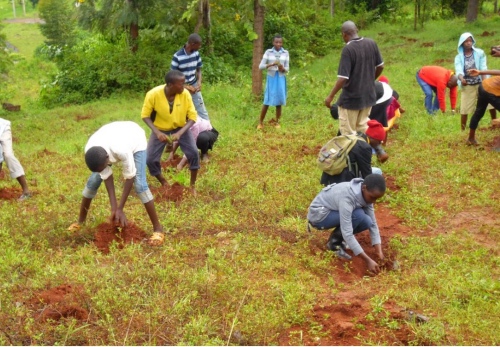When Leah Mutembei was growing up in Kajuki, a village in central Kenya, most farms were dotted with avocado and mango trees.
“But now they have all gone,” the 32-year-old maize farmer said from her homestead, gesturing to the barren land nearby.
“We had to cut them to make firewood and charcoal,” she said.

Students plant trees at Kamachuki primary school, Tharaka Nithi County in Kenya on 14th April. PICTURE: Caroline Wambui/Thomson Reuters Foundation.
In this largely agricultural area hit by erratic weather and insufficient rain, farmers are making up for poor harvests by cutting down trees and selling the wood for timber and charcoal.
But the destruction of fruit trees, in particular, is depriving local communities of a key source of food and nutrition, experts say – and one they can fall back on when crops fail.
“Mangoes, avocadoes and bananas are full of vitamins and are especially crucial for children’s growth,” said David Mugambi, a lecturer in natural resources management at Kenya’s Chuka University.
“Excessive cutting of fruit trees deprives people of a significant part of their diet,” he told the Thomson Reuters Foundation.
Since 1999 it has been illegal to cut down trees in Kenya’s forests, and a new constitution in 2010 extended the bank to rural farms.
“Tree cutting is illegal in Kenya unless one has a licence signed by the forest officer, the sub-county officer and the region chief,” explained Nicholas Mokaya, an agricultural officer for Tharaka Nithi County in central Kenya.
“But that hasn’t stopped people from bribing officials and cutting trees at night,” he said.
Growing demand for firewood and timber from tea factories in the Mount Kenya area has speeded the cutting of trees, and fruit trees are particularly valued for their high-quality wood, Mr Mugambi said.
“So you just don’t find as much fruit in the area anymore,” he added.
Many fruit trees are particularly resistant to both drought and wet weather, he said, making them a reliable source of good food in bad times.
“Fruit trees can grow in harsh conditions and have long roots that extract minerals and water from the soil, so it’s hard for them to dry up,” he said.
Betty Murungi, a sorghum and millet farmer in the Kajuki area, said people cut fruit trees on their land “because they don’t realise how crucial they are to our nutrition and health”.
She said she does not cut any trees to sell.
Loss of fruit trees is worsening an already precarious food situation, particularly as droughts worsen, Mr Mugambi said.
Stephen Mwendwa, a pea farmer in Tharaka Nithi County, said three years ago his family relied on mango trees on their land for food and for an income, with surplus mangoes sold at the market.
“But we didn’t have enough money so we had to cut our beautiful trees and sell them,” he said.
Many families like his now survive on one meal per day, he added.
The county government has embarked on a tree planting drive to try to protect the remaining forests in the area, Mr Mokaya said. The push is part of an effort to see at least 10 per cent of Kenya’s land covered in trees by 2030.
“We are planting trees on public land like schools and hospitals, and encouraging people to do the same,” he said.
Green TNC, a charity, has organised tree-planting initiatives in schools, with students planting hundreds of saplings – at least half of them fruit trees – at 25 schools.
Terry Makena, one of the group’s founders, said it chose to target schools because “young people are more receptive to new ideas”.
“Hopefully teaching them these good practices now will ensure they stick in the future,” he said.





